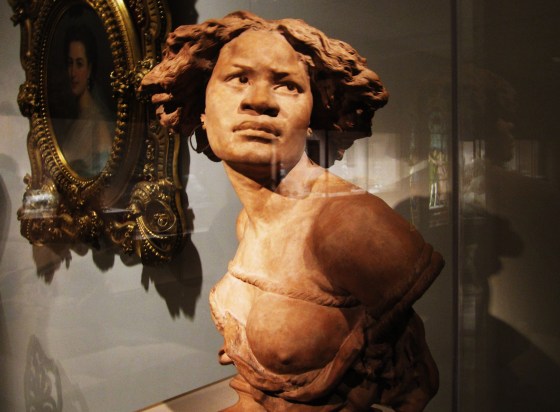Reportage by Lina Thompson

Her skin is like dusk on the eastern horizon,
O cant you see it, O cant you see it
-- Jean Toomer, Cane
She sits on the edge of the display surrounded by decorative arts and jewels. Her raw terracotta skin contrasts sharply with things that glitter under the bright light. She doesn’t see them. Her head is turned, eyes lifted upward, face unmoved. She doesn’t have a name, and she doesn’t need one. Her face is an image, a figure onto which many will project fear, love, anger, and hate. They will give her a name. She asks a single question in response—pourquoi! Naître une esclave! (Why! Born a slave!)
For now, she is known as “La Négresse,” a final commission of work produced by Jean-Baptiste Carpeaux. One of the most well-known and well-respected sculptors of Second Empire France, Carpeaux created this thirteen-inch terracotta bust in 1872 as a replica of a much larger, much more complex sculpture titled “Fontaine des Quatre-Parties-du-Monde” (Four Parts of the World Sustaining the Globe). “La Négresse’s” prototype represents Africa—her arms stretched gracefully above her head to hold the globe. “Four Parts” is emblematic of many of Carpeaux’s virtues as a visionary sculptor and humanitarian.
Carpeaux, the son of stonemasons from Valenciennes, France, began his career as an apprentice to a plasterer. He initially enrolled in Académie de Peinture, Sculpture et Architecture in his hometown and later began studying at the Petite Ecole in Paris. Already a talented craftsman, Carpeaux finished his education at the École Nationale Supérieure des Beaux-Arts. While at Beaux-Arts, he also trained under the guidance of Francois Rude and Francisque Duret whose Romantic notions of art and beauty would influence Carpeaux’s work. Carpeaux’s genius centered upon his ability to portray humanity with a remarkable sensitivity and care. He was attuned to the movement and the drama of the human body and was regarded as one of the most talented portraitists of his day.
In 1867, Georges-Eugène Haussman, better known as Baron Haussman, commissioned Carpeaux to design a fountain for the gardens of Luxembourg Palace. Out of this commission came the famous “Four Parts of the World Sustaining the Globe.” Four women, representing the major regions of the world (Africa, America, Asia, and Europe), reach overhead to carry a sphere bound by gold rings. These Atlas-like women demonstrate Carpeaux’s talent for showcasing the grace and emotion inherent in the human body. Moreover, Carpeaux sculpted each woman with a remarkable sense of detail, imbuing the work with a sense of historical consciousness. Africa, for example, stands with a manacle around her leg while America, boasting a headdress of feathers, keeps one foot on the chain that binds Africa. Carpeaux uses these symbols to create a cross-cultural language between the continents and their inhabitants. The images become reference points with which the observer can create a sense of global and human awareness.
The bust of “La Négresse,” a more commercial rendering of the inspiring “Four Parts,” retains every bit of Carpeaux’s signature style and flair for history and drama. Even without a full body in which to mark movement, “La Négresse” displays a neck that is turned to the side, shoulders thrust forward, and an elegantly arched back. Ropes bind her full breasts as her brows furrow and her eyes stare upward. Her facial expression is intriguing and Carpeaux’s inscription haunting: Why! Born a slave!
It is through the physical appearance of this African woman that Carpeaux expects us to understand, conceptualize, and hopefully challenge the definition of slave and of human. He grasps at a way to define her selfhood beyond her title. This black woman stands not as a slave but as a pillar of civilization. Carpeaux attempts to set in stone, to stabilize, the image of a black woman, of her body, and of her humanity. But, theorists like Michel Foucault would later tell us that the body is a contested space, a construction that reflects the shifting dialogue humans have with each other and with nature. According to Foucault, the body is, above all, a most unstable entity and, outside the context of culture, has no meaning at all.
The black and brown bodies of African slaves have garnered their definition in a distinctly American context. The black female slave, in particular, reflects the sum total of historical assumptions about blackness and about femininity. Arriving to the New World, naked, emaciated, and withering with physical and emotional sickness, the black woman’s body became a space onto which sexual fears and desires could run free. She incited fear, hate, tenderness, and affection all at once. As the abolitionist movement gained momentum during the 19th century, writers would look to black slave women to inspire pity and invoke support for the cause of freedom. Her body, chastity and virtue were at risk under the shackles of slavery. In 1831, Harriet Jacobs, a freed slave who had suffered years of sexual abuse at the hand of her master, gave voice the violence she suffered in her autobiography Incidents in the Life of a Slave Girl. Her accounts originally appeared in the New York Tribune, but the editors found her descriptions of her life as a slave too graphic for the Tribune’s readers and cancelled Jacobs’ commission. Thirty years later a Boston publishing house agreed to finance and distribute Jacobs’ autobiography in an effort to galvanize white women to support the cause of abolition.
The black woman’s sexuality immediately became subject to public scrutiny. The master-slave relationship had distorted and prejudiced the image of the black woman. A slave owner looking for forgiveness from his wife would cast his victims off as sexually promiscuous women who had led him astray. All history, Foucault has said, is the story of the destruction of the body. Jezebels and harlots, black women, with no rights, no education, and no public voice would stand helpless as American culture began to destroy the black body by defining what a black woman could and could not be.
In her well-known work Gender Trouble, Judith Butler understands Foucault’s definition of the body as a surface that, “is always under siege, suffering destruction by the very terms of history.” “History,” she further explains, “is understood as that creator of values and meanings, that signifying practice, which requires the subjection of the body in order to produce the speaking subject and its significations.” After the abolition of slavery, the ebbs and flows of history continued to constrict the parameters of the black woman’s physicality—white apologists for slavery would replace the image of the sexually violated black woman with an image of an asexual, overweight, and benignly maternal woman. Mammy, that lovable old maid who nursed white children in place of her own, became a relic of the Lost Cause, an attempt to re-cast black-white relations as interactions based on love and loyalty.
Hattie McDaniel and many others would be credited with bringing Mammy to life on the big screen. Surly and strong, Mammy, and her culinary counterpart Aunt Jemima, became immortalized, mythologized, and fundamentally misunderstood in American culture. Mammy even made a comeback in 2011 with the runaway hit film and novel The Help. The film’s juxtaposition of gender and race was anything but subtle. The maids, buxom and robust, stand out compared to the slender and petite white women for whom they work. Perhaps Angela Bassett and Kerry Washington were too busy for the film adaptation of the novel. Or, perhaps, they simply didn’t reflect the image of black women that American culture had already developed for black hired help.
We are a culture based on images; we are consumers of visual and aesthetic style. A picture, an image, a body, a life indeed is worth a thousand words. And, the struggle between the body and cultural history continues today—black women are still mired in definitions they had no part in creating and can now find themselves to be colluders in their own oppression. A cursory glance through the media tells young black women who they are allowed to be: from the video vixen, the wholesome maid, to the sassy sidekick, and more recently, the desperate and lonely single black female. Perhaps, then, it is not so outlandish that any black woman thrust into the light of the media finds herself hyperaware of her image, acutely sensitive to the way that she is portrayed. Definitions, Toni Morrison has said, belong to the definers. And this, above all else, might be the root of the problem. Nobody really knows the black girl’s name. Nobody asked. So, like “La Négresse” sitting stony and silent in the decorative arts wing of the Met, black women wait patiently for “somebody, anybody to sing a black girl’s song.”
